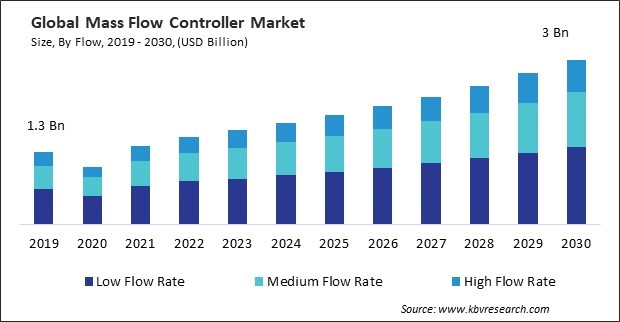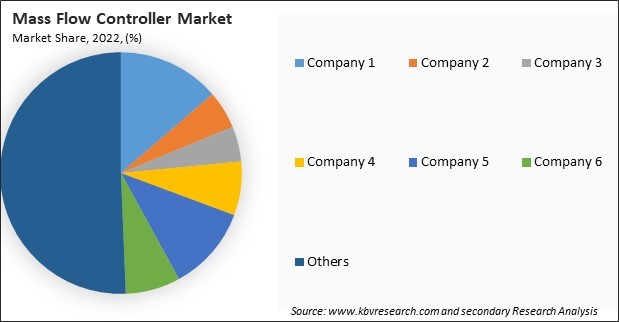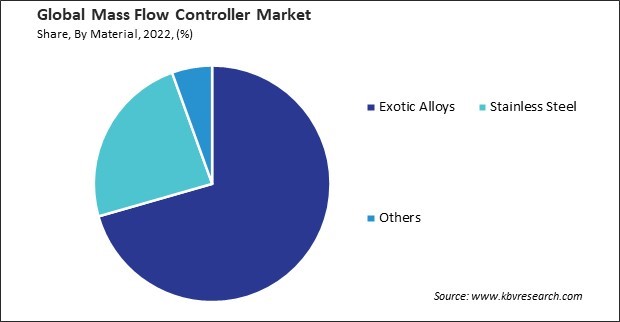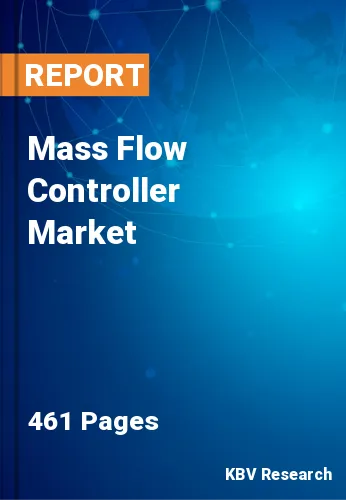“Global Mass Flow Controller Market to reach a market value of USD 3 Billion by 2030 growing at a CAGR of 8.3%”
The Global Mass Flow Controller Market size is expected to reach $3 billion by 2030, rising at a market growth of 8.3% CAGR during the forecast period. In the year 2022, the market attained a volume of 1980.6 thousand units, experiencing a growth of 8.1% (2019-2022).
In the oil and gas industry, mass flow controllers are of the utmost importance as they regulate gas and liquid fluxes in several midstream, upstream, and downstream applications with extreme accuracy and dependability. Consequently, the oil and gas segment would generate approximately 10.92 % share of the market by 2030. These instruments are essential in the oil and gas industry for optimizing manufacturing procedures, maintaining safety and environmental compliance, and increasing productivity due to their dependability, consistency, and interoperability with hazardous and corrosive fluids.

Mass flow controllers (MFCs) play a pivotal role in semiconductor fabrication processes by precisely controlling the flow of gases used in various manufacturing steps. For instance, during chemical vapor deposition (CVD), MFCs regulate the flow of precursor gases to deposit thin films onto semiconductor wafers with high precision and uniformity. Therefore, the semiconductor industry's expansion is propelling the market's growth.
Additionally, Alternative energy sources often rely on precise gas flow control during production processes. For example, in solar cell manufacturing, MFCs regulate the flow of gases used in chemical vapor deposition (CVD) processes to deposit thin films of semiconductor materials onto substrates. Hence, the demand for alternative energy sources drives the market's growth.
However, The purchase price of mass flow controllers can be substantial, particularly for high-precision models, specialized configurations, or those designed for specific gases or flow rates. The cost of MFCs depends on factors such as flow range, accuracy, response time, materials of construction, and additional features such as digital communication interfaces. Thus, the high initial investment costs are impeding the market's growth.

The leading players in the market are competing with diverse innovative offerings to remain competitive in the market. The above illustration shows the percentage of revenue shared by some of the leading companies in the market. The leading players of the market are adopting various strategies in order to cater demand coming from the different industries. The key developmental strategies in the market are Acquisitions, and Partnerships & Collaborations.
Based on material, the market is divided into exotic alloys, stainless steel, and others. The stainless-steel segment attained a 23.92 % revenue share in the market in 2022. Stainless steel is renowned for its excellent corrosion resistance properties, making it highly suitable for MFC applications where exposure to corrosive gases is common. Therefore, the corrosion-resistant properties of the segment are driving its growth.

On the basis of flow, the market is segmented into low flow rate, medium flow rate, and high flow rate. In 2022, the low flow rate segment attained the 49 % revenue share in the market. In analytical chemistry, gas chromatography requires accurate and precise control of carrier gas flows at low rates to separate and analyze chemical compounds in samples. Hence, applying low flow rate in the research laboratories is driving the segment's growth.
Based on media type, the market is categorized into gas, liquid, and others. The liquid segment witnessed a 29.85 % revenue share in the market in 2022. Liquid mass flow controllers are critical in the food and beverage industry in controlling liquid flows in mixing, blending, and bottling operations. Therefore, expanding the food and beverages industry propels the segment's growth.
Based on industry, the market is divided into semiconductors, oil & gas, chemical, pharmaceuticals, food & beverages, water & wastewater treatment, metals & mining, and others. The semiconductors segment attained the 37.86 % revenue share in the market in 2022. MFCs regulate the flow rates of precursor gases, such as silane (SiH4), ammonia (NH3), and tungsten hexafluoride (WF6), used for depositing thin films onto silicon wafers. Mass flow controllers are indispensable tools in the semiconductor industry, providing precise and reliable control of gas flows essential for various manufacturing processes, device fabrication steps, and semiconductor material treatments.
Free Valuable Insights: Global Mass Flow Controller Market size to reach USD 3 Billion by 2030
Region-wise, the market is analyzed across North America, Europe, Asia Pacific, and LAMEA. The North America region witnessed a 25.57 % revenue share in the market in 2022. North America is home to a significant portion of the global semiconductor industry, with prominent semiconductor fabrication facilities in the United States and Canada. As semiconductor manufacturing processes become more sophisticated and precise, the demand for MFCs to control the flow of gases in deposition, etching, and cleaning processes has increased.
| Report Attribute | Details |
|---|---|
| Market size value in 2022 | USD 1.6 Billion |
| Market size forecast in 2030 | USD 3 Billion |
| Base Year | 2022 |
| Historical Period | 2019 to 2021 |
| Forecast Period | 2023 to 2030 |
| Revenue Growth Rate | CAGR of 8.3% from 2023 to 2030 |
| Quantitative Data | Volume in Thousand Units, Revenue in USD Billion, and CAGR from 2019 to 2030 |
| Number of Pages | 461 |
| Number of Tables | 970 |
| Report coverage | Market Trends, Revenue Estimation and Forecast, Segmentation Analysis, Regional and Country Breakdown, Market Share Analysis, Porter’s 5 Forces Analysis, Company Profiling, Companies Strategic Developments, SWOT Analysis, Winning Imperatives |
| Segments covered | Material, Flow, Media Type, Industry, Region |
| Country scope |
|
| Companies Included | Parker Hannifin Corporation, Sensirion AG, Halma PLC, MKS Instruments, Inc., Azbil Corporation, Bronkhorst High-Tech B.V., Brooks Instrument LLC (Illinois Tool Works Inc.), Sierra Instruments, Inc. (TASI Group), Tokyo Keiso Co., Ltd., Horiba Ltd. |
By Material (Volume, Thousand Units, USD Billion, 2019-2030)
By Flow (Volume, Thousand Units, USD Billion, 2019-2030)
By Media Type (Volume, Thousand Units, USD Billion, 2019-2030)
By Industry (Volume, Thousand Units, USD Billion, 2019-2030)
By Geography l (Volume, Thousand Units, USD Billion, 2019-2030)
The Market size is projected to reach USD 3 billion by 2030.
Increasing Demand For Semiconductor Manufacturing are driving the Market in coming years, however, High Initial Investment Costs restraints the growth of the Market.
Parker Hannifin Corporation, Sensirion AG, Halma PLC, MKS Instruments, Inc., Azbil Corporation, Bronkhorst High-Tech B.V., Brooks Instrument LLC (Illinois Tool Works Inc.), Sierra Instruments, Inc. (TASI Group), Tokyo Keiso Co., Ltd., Horiba Ltd.
In the year 2022, the market attained a volume of 1980.6 thousand units, experiencing a growth of 8.1% (2019-2022).
The Gas segment is leading the Market by Media Type in 2022 there by, achieving a market value of $1.8 billion by 2030.
The Asia Pacific region dominated the Market by Region in 2022 there by, achieving a market value of $1.4 billion by 2030, growing at a CAGR of 8.4 % during the forecast period.
Our team of dedicated experts can provide you with attractive expansion opportunities for your business.

 Drivers
Drivers
 Restraints
Restraints
 Opportunities
Opportunities
 Challenges
Challenges
